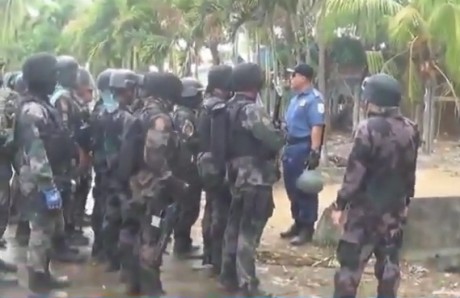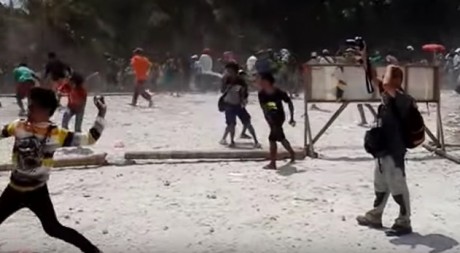Here is what the commie groups Gabriela and the Kilusang Mayo Uno (KMU) should have advised the farmers in Kidapawan when they decided to air their grievances through a rally last Friday, the 1st of April. “Let’s organise a protest and attract attention to our cause. The police will come. If they disperse us, stand your ground but don’t attempt to physically assault a police officer. Let them carry you out if necessary.”
Unfortunately, that is not what happened nor was there any evidence that such a peaceful outcome was planned by the rally organisers from the onset. Former Bayan Muna congressman Teddy Casino recounted in a tweet how “farmers retaliated by picking up stones by the road and hurling [them] at the cops.”
Even more disturbing is the possibility that some elements of the protesters were armed. In the video provided below, there seems to be evidence of shots being fired at the police. Footage between 1:01 and 1:07 of the video shows what looks like bullets hitting the ground next to firetrucks and police officers at the scene…
One wonders, indeed, why there was a contingent of what look like police Special Action Force (SAF) troopers deployed to the scene. The inclusion of a heavily-armed and well-trained unit of the PNP could indicate that they had been prepared to face possibility of armed elements being amongst the protesting mob. Interestingly enough, GMA News Online reports that a commander of the New People’s Army (NPA), the terrorist arm of the Communist Party of the Philippines “was among those arrested after the violent dispersal of protesting farmers”. And a PNP Scene of Crime Operations (SOCO) report released today revealed evidence that some of the rallyists may have discharged firearms…
One of the dead rallyist yielded positive results during the paraffin test. The SOCO team also recovered 2 empty shells of calibre .45 at the area previously occupied by the rallyists and a deformed slug of calibre .38 at a makeshift station previously occupied by our police.
A police officer takes cover as shots are fired during efforts to disperse rallying farmers in Kidapawan.
Video footage also shows elements of the government troops in the area assuming defensive positions, possibly taking cover from gunfire.
Indeed, the SOCO report also showed that 99 PNP personnel were injured during the melee. That a PNP contingent supposedly (as many observers have insisted) far more fit, better-protected, and better-armed than the rallyists they faced would sustain such a large number of casualties says something about the ferocity of the rallyists’ assault against them.
Considering then that the rally was organised by supposedly experienced“progressive” groups like the KMU and Gabriela who, if the objective was to send a message across and not foment unrest, should have known better than to encourage rallyists to assault police officers, the violent behaviour of the rallyists could be considered quite baffling.

Heavily-armed Philippine Police officers regroup after rallying farmers are forcibly dispersed in Kidapawan.
Then again, Kidapawan City is located in North Cotabato, a recognised stronghold of the NPA and, as such, it is hardly surprising that police and army units stationed there tend to be on a high state of alert. Back in 2014, the NPA detonated a roadside bomb that injured two Philippine Army personnel in Barangay Balite, Magpet. This was shortly followed by the burning of heavy equipment of a construction company near Mt Apo. Police also reportedly tagged the NPA as the perpetrators of this crime…
About 12 heavily armed rebels arrived in Mua-an, and then poured gasoline and torched the equipment used in the construction of a road network connecting Mua-an and Barangay Ilomavis. The equipment had been parked near the village hall.The rebels then fired their weapons and left, chanting, “We are NPA.”Kidapawan Councilor Francis Palmones, chair of the committee on peace and order, condemned the attack and urged the police to file charges over what he described as “terrorist act.”“They (NPA) sow terror in our city. I condemn the act and considered it as barbaric as it caused panic and fear among constituents in Barangay Mua-an,” Palmones said as he appealed to the rebels to spare the city and its people.
The NPA’s mission is to carry out that infamous “armed struggle” that has been the trademark of every communist movement around the world. Chairman Mao Tse-tung wrote about this “armed struggle” in 1939 (text formatted in boldface for emphasis)…
What is guerrilla warfare? It is the indispensable and therefore the best form of struggle for the people’s armed forces to employ over a long period in a backward country, a large semi-colonial country, in order to inflict defeats on the armed enemy and build up their own bases. So far both our political line and our Party building have been closely linked with this form of struggle. It is impossible to have a good understanding of our political line and, consequently, of our Party building in isolation from armed struggle, from guerrilla warfare. Armed struggle is an important component of our political line. For eighteen years our Party has gradually learned to wage armed struggle and has persisted in it. We have learned that without armed struggle neither the proletariat, nor the people, nor the Communist Party would have any standing at all in China and that it would be impossible for the revolution to triumph. In these years the development, consolidation and bolshevization of our Party have proceeded in the midst of revolutionary wars; without armed struggle the Communist Party would assuredly not be what it is today. Comrades throughout the Party must never forget this experience for which we have paid in blood.
Communists, it seems will always be at fundamental odds with any incumbent government. As such, they will likely only accept its absolute and complete destruction and, thus, makes any attempt on their part to participate “legitimately” in the institutionalised political processes of any incumbent government — such as its elections — plain and simple suspect.
Some people are quick to dismiss the linking to communists of leftist personalities like Casiño who are engaged in some sort of “legal” participation in legitimate Philippine politics as a decades-long “black propaganda” effort mounted by one government after another against left-leaning polticians. The question this raises, however, is quite simple: Why does the perception that leftists are linked to the NPA stubbornly persist? It seems no convincing argument to support the contrary has been put forth.
The common denominator in all this is former Congressman Saturnino “Satur” Ocampo who chairs the Bayan Muna partylist in which Casiño is a member. Notably, Satur Ocampo is a co-founder of the National Democratic Front (NDF) which is widely-believed to be one of the key front orgnisations of the CPP-NPA. According to its Wikipedia entry the NDF lists as one in its 12 point program of “national liberation and democracy” an aim to “unite the people for the task of overthrowing the semicolonial and semifeudal system through a people’s war and completing the national democratic revolution.” This of course may be interpreted in various ways, but it remains consistent with the overall Maoist ideology that Philippine communists subscribe to.

Protesters in Kidawpawan throw rocks at police officers sent to disperse them. 99 officers were reportedly injured in the melee.
The history of Philippine communists’ “legitimate participation” in mainstream Philippine politics could possibly be traced back to the rise to power of the late Corazon “Cory” Aquino, mother of current president Benigno Simeon “BS” Aquino III. A GlobalSecurity.org report suggests that the popularity of the Cory Aquino government with the people forced the NDF-CPP-NPA brass to re-evaluate its approach to “revolution”…
As a result of the world-wide known “People Power” revolution in the Philippines, the National Democratic Front (NDF) made a comprehensive analysis on the new situation in the Philippines. The new government was viewed as a fragile coalition of the right and bourgeoise liberals. However, the Aquino government has a broader power base than the Marcos regime. As such, it adopted a critical collaboration stance with the present government fielding some of its members to fill some some post in government. With this style they could penetrate the bureaucracy while waiting for the Aquino government to weaken so the NDF goal can be fulfilled.
…which brings us to the present and what looks like a cadre of “ex”-communists who appear to have dropped their AK-47s in favour of peaceful and “productive” partaking in mainstream politics.
So the question remains: Are these “leftists” in Philippine Congress really ex-communists? Or are they merely dormant ones for the time being — waiting for the right moment to strike in the same manner that “sleepers” blend into the mainstream of a society they ultimately plan to destroy someday?

No comments:
Post a Comment